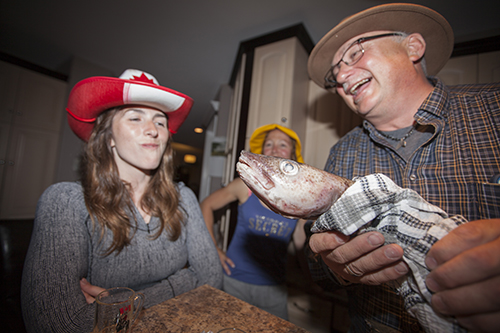Moments in Newfoundland History
c. 3000 B.C. – Stone Age Indians (Maritime Archaic Indians) moved to the Island of Newfoundland.
c. 800 B.C. – Palaeo-eskimos (Groswater Palaeo-eskimos) moved to the Island of Newfoundland.
1 A.D. – Dorset Palaeo-eskimos arrived into Newfoundland
c. 1000 – Viking settlement established at L’Anse aux Meadows
c. 1000 – Historical and archeological evidence indicates that the Bethouks were already living in Newfoundland at the time that Viking explorers arrived.
1497 – John Cabot arrived in Newfoundland, landfall at Bonavista, claimed land as British colony
1610 – First colony established at Cupids by London and Bristol merchants; John Guy first governor
1660’s – French established colony at Placentia
1713 – French lost all territory in Newfoundland under Treaty of Utrecht; maintained fishing rights
1756 – 1763 – Seven Years War between French and English; French claimed many settlements
1763 – Seven Years War ended; Treaty of Paris gave French fishing rights to French Shore, Territory of St. Pierre, Miquelon
1809 – Labrador Act gave Labrador to Newfoundland
1824 – Newfoundland recognized as an official British colony by Imperial legislation
1833 – The House of Assembly met for the first time
1840 – J.B. Jukes completed first geological survey of Newfoundland
1855 – Responsible government established; Philip Frances Little elected first prime minister
1866 – Atlantic telegraph cable laid between Heart’s Content and Cork, Ireland
1869 – Issue of Confederation with Canada defeated in a general election
1894 – Two Newfoundland banks crashed, began depression in Newfoundland
1896 – Miners at Bell Island struck for two-cents an hour raise
1898 – Railway across Newfoundland completed
1914 – Newfoundland joined Britain in World War I
1923 – Women 25 or older won right to vote
1933 – Newfoundland ran out of money; House of Assembly closed, Responsible Government ended
1939 – One-half of workforce on government relief; World War II began
1941 – American troops arrived St. John’s; constructed American naval base at Argentia
1942 – German submarine torpedoed ferry, SS Caribou, 127 passengers killed; German submarines sank 4 ships at Bell Island, 70 killed; American naval ships Truxton and Pollux lost off St. Lawrence with 189 officers killed
1947 – St. John’s businessmen formed Responsible Government League to make Newfoundland and Labrador independent country with elected government
1949 – Newfoundland became 10th province of Canada; Joseph Roberts Smallwood elected first premier of Newfoundland
1960 – Evidence of Viking colonization of North America discovered in Newfoundland
1966 – Bell Island Mine closed and flooded
1985 – Titanic wreck found 400 miles east of Newfoundland at a depth of 13,000 feet
1992 – The federal government closed northern cod fishery
1997 – Hibernia offshore drilling platform pumped first barrel of oil
Screeching

For those of us that are not drinkers, Newfoundland Screech is a a substance better used for wound cleaning than human consumption. The amber liquid boats 40% and is a key player in a ceremony called a “Screech-In.”
Newfoundlanders perform an optional ceremony for visitors who “come-from-away” to formally welcome their new friends as honorary Newfoundlanders. The ceremony includes eating some traditional niblets of local survival food such as hard tack biscuits, salted dried fish and pressed meat that looks like boloney (Newfie Steak).
The ceremony usually begins and ends with lots of local folk music which is interrupted by the official recitation. The leader introduces themself and asks the participants if they would like to become a Newfoundlander.The proper response, would be a hearty “Yes b’y!” Each participant is asked to introduce themselves and their hometown, often interrupted by the ceremony leader who pokes fun at their accent.
Finally, each individual is given a small dram of screech and are asked, ”Are ye a screecher?”
The response is: “’Deed I is, me ol’ cock! And long may yer big jib draw!” (Though with a Newfie accent, it often sounds like this: “‘Deed Oi is, mee-all cahk! An’ lahng may-yer big jib-jrah.”) Translated, it means “Yes I am, my old friend, and may your sails always catch wind.”
After the shot, the screecher must kiss a cod fish – or any other fish ugly enough to suitably replace the cod. Oftentimes, a certificate is offered after the ceremony. In some cases, participants stand in a bucket of saltwater and wear a bright yellow Sou-wester hat.
1985 Documentary and archival footage from the 1960s on Bell Island
Learn about the faery legends of Bell Island